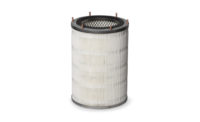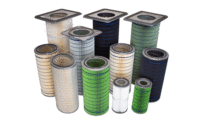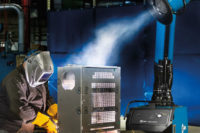Choosing the appropriate filter media for a fume extraction system can help increase productivity and profitability by lowering downtime, improving airflow and reducing filter replacement costs, among other factors. More importantly, the efficiency of the filter, in terms of minimal resistance to airflow, helps keep the fume extraction system performing at a high level, ensuring the system is effectively capturing fume and keeping it out of the welding operator’s breathing zone.
As agencies such as OSHA and ACGIH (American Conference of Governmental Industrial Hygienists) continue to implement stronger and more stringent regulations regarding personal exposure limits to elements such as manganese and hexavalent chromium, fume extraction is more important than ever across the industries and applications that involve welding.
This article discusses how choosing the right filter media for a fume extraction system can help produce a cleaner, more compliant and more productive work environment, and lower costs over time.
Filter ratings
Filters for fume extraction systems are assigned a MERV rating, which stands for “Minimum Efficiency Reporting Value.” These ratings gauge the ability of the filter media to remove particles from the air, and the number is a reliable standard for measuring the efficiency of a filter.
The MERV scale ranges from 1 to 16, and measures a brand-new filter’s ability to remove particles from 0.3 to 10 microns in size (one-thousandth of an inch is 25 microns, to give an idea of the small size of these particles). Among all weld fume generated, 75 to 95 percent of it is in the size range from 0.3 to 1 micron in size, or roughly 1/100th the width of a human hair. Filters with higher MERV ratings not only remove particles from the air, but they also remove the smaller particles in weld fumes that are most concerning for worker protection. Ratings around 15 to 16 are ideal.
Weld fumes of all types, whether from aluminum, carbon steel, stainless or galvanized steel, are basically similar in size and shape: the fumes are thermally generated particles that require high levels of filtration. The types of particulates removed by filter media include manganese, hexavalent chromium and copper — common fumes generated by the different types of welding wire.
Filters with the highest efficiencies and the lowest pressure drops typically capture fumes better, last longer and have lower operating costs.
Note, filters for fume extraction systems do not capture odor, fluids or VOCs (volatile organic compounds) such as exhaust fumes or paint smells.
Types of filter media
There are various types of filter media, each with their own characteristics. Some basic categories include cellulose, cellulose blend, spunbond polyester and melt-blown composite. Each offers various fume capture benefits. For example, cellulose filters are used for general filtration of larger size particulate and have low capture efficiency, while tighter-weave melt-blown composite filters are designed to capture more particles, but feature a reduced filter life.
A filter with the highest level of fume capture efficiency combined with the lowest level of pressure drop can maximize performance and effectiveness. Pressure drop refers to the filter’s resistance to airflow and the amount of pressure it takes to pull the air through the mesh of the filter.
A filter media that incorporates a very thin nanofiber layer collects the majority of weld fume particles on the surface of the filter.
Nanofiber filters
Filters with nanofiber technology have a very thin surface layer that offers high efficiency in filtering the smallest of weld fume particles. This thin layer also offers low-pressure resistance, so the filter is easier to clean, allowing the high fume capture efficiency to be maintained for a longer period of time. A cleaner filter also allows for a higher airflow (cubic feet per minute or cfm), which directly impacts the capture velocity of the air that’s pulling the weld fume away from the welding operator’s breathing zone.
Savings also can be found in the easier cleaning of nanofiber filters. Capturing particles on the surface allows for weld fume to accumulate on the top of the filter without penetrating into the media itself. This lack of penetration allows for the particles to be released much easier during the cleaning process (which is often done internally in the fume extraction system with compressed air), creating more efficient cleaning that requires less compressed air usage.
While the purchase price of high-performance nanofiber filters can be higher when compared to the various types of depth-loading filters, consider the return on investment that nanofiber filters can provide thanks to longer filter life; reduced energy costs in filter operation and cleaning; and reduced frequency of filter replacement.
Proper filter cleaning
Many fume extraction systems include a mechanism to internally clean filters using a reverse pulse of compressed air. A valve releases stored energy in the form of a reverse pulse of air that blows air through from the clean side of the filter to remove the weld fume particles collected on the dirty side of the filter.
As it becomes harder to move air through the filter, that’s a signal the filter needs to be cleaned or replaced. Most fume extraction systems have an indicator light, gauge or display that measures the pressure difference between the clean and dirty sides of the filter, to alert welding operators that the filter has reached maximum loading capacity and needs to be cleaned or replaced.
The weld fume particles removed during the internal cleaning process are collected in a bin or drum. Consult a waste hauler to have the matter evaluated, in order to create an action plan for properly disposing of the collected particles. Follow the same procedure to properly dispose of used filters.
Other tips for best use
Some other general tips and guidelines can help maximize the performance and efficiency of fume extraction systems and filters.
When cleaning a filter, for example, make sure to use dry compressed air to avoid blowing moisture into the filters, which can reduce filter life.
Base metal that is clean and dry for the welding process can contribute to lower fume generation, which helps improve the efficiency of fume extraction systems and maximize filter life and performance.



